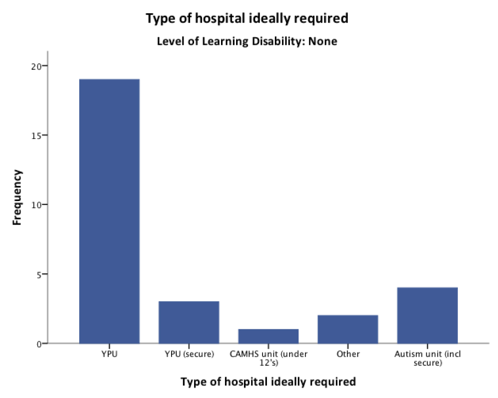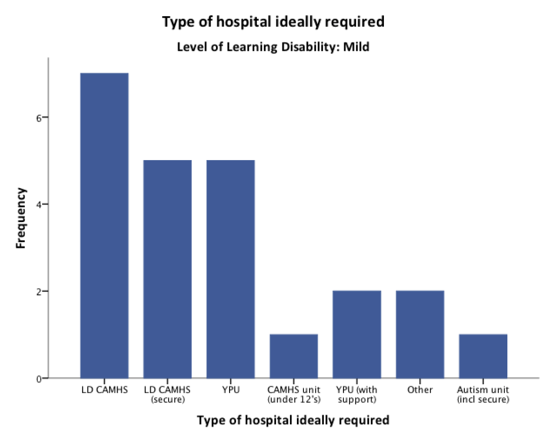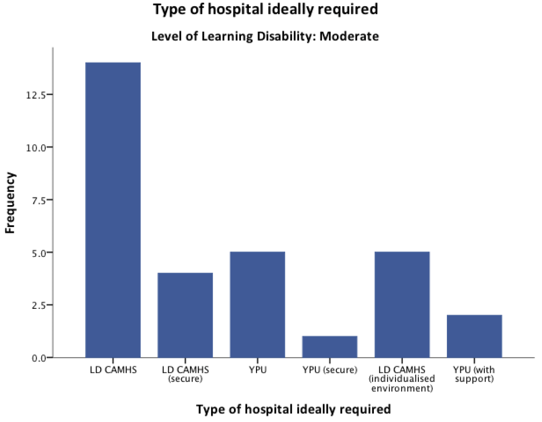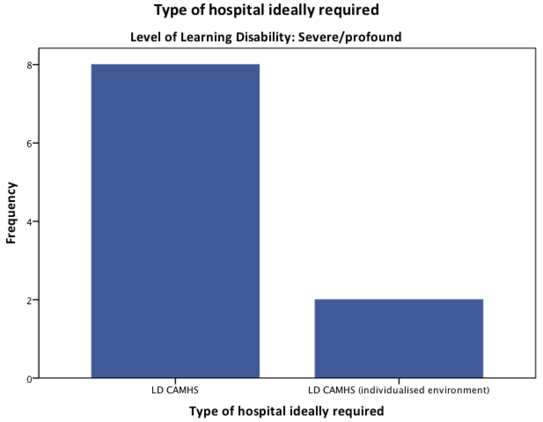Child and Adolescent Mental Health Services: inpatient report
A report recommending improvements to respond better to the needs of children and young people with Learning Disability (LD) and/or autism.
A4.19 Data on clinicians' opinions on type of hospital ideally required by their patients
This data is for patients included in the study, not individual admissions. It represents the views of the clinicians submitting information as to the type of ideal hospital unit required by the patients described. It includes 5 of the patients that were not admitted to hospital but required to be.
- 45 patients required an LD CAMH inpatient unit
- 9 of these required a secure LD CAMH inpatient unit
- 7 of these required an individualised environment
- 37 patients required a 'mainstream' adolescent mental health inpatient unit (not LD or ASD specific)
- 29 of these required YPU
- 4 of these required a secure YPU/adolescent inpatient unit
- 4 of these required YPU but with additional learning disability-specific support
- 5 patients required an ASD-specific provision (including secure)
- 2 patients required CAMH under 12's inpatient unit
- 4 patients required 'other' (these included a small number whose psychiatrists felt that they were appropriately placed on an adult LD ward as they were very near to their 18 th birthday and this aided transition planning for ongoing services).
Therefore, of patients in the study, at least 35 were considered suitable for existing Scottish resources and 54 patients required inpatient units not presently available in Scotland.
A4.19.1 Actual admission destinations for those requiring specialist LD CAMH inpatient unit
The 45 patients identified by their clinicians as requiring a specialist LD CAMH inpatient unit had 76 periods of inpatient care, mostly due to transfers during 1 continuous admission, but some requiring more than one separate admission.
Of those periods of care in Scotland:
- 23 were to adult LD wards (including secure)
- 21 were to adult mental health wards (including IPCU and secure)
- 12 were to CAMH inpatient wards
- 6 were not admitted to any hospital
- 4 were to pediatric wards
10 periods of care were in CAMH inpatient units in England (mostly specialist LD CAMH inpatient units).
The following table gives more detail on these admissions, including information about those requiring secure or individualised LD CAMH admissions.
| Mental health inpatient unit required → Mental health inpatient unit (or other) admitted to ↓ |
LD CAMHS | LD CAMHS (secure) | LD CAMHS (individual-ised) | Total LD CAMHS |
|---|---|---|---|---|
| Adult mental health (including IPCU & forensic) | 6 | 15 | 0 | 21 |
| Adult LD (including secure) | 13 | 3 | 7 | 23 |
| YPU | 6 | 1 | 2 | 9 |
| Paediatric | 4 | 0 | 0 | 4 |
| Non-hospital | 2 | 1 | 0 | 3 |
| Stayed at home | 3 | 0 | 0 | 3 |
| National Child Psychiatry Inpatient Unit | 3 | 0 | 0 | 3 |
| YPU (Secure, England) | 0 | 1 | 0 | 1 |
| LD CAMHS (including private, England) | 5 | 3 | 1 | 9 |
| Total number of periods of inpatient care | 42 | 24 | 10 | 76 |
| Total number of patients requiring this | 29 | 9 | 7 | 45 |
A4.19.2 Type of hospital ideally required by those with different levels of learning disability
Note that the y axis (frequency) has different scales in the following 4 different graphs.




A4.19.3 Profiles of those requiring different types of specialist units
Numbers were too small to quote for all the different types of specialist units thought to be ideally required, so the main data given below pools data for those requiring learning disability-specific and those requiring non-learning disability-specific units. However, trends for patients requiring different types of units were as follows:
- LD CAMH inpatient unit (non-secure) had a range of levels of learning disability.
- LD CAMH inpatient unit (secure) – vast majority were male with mild learning disability, aged 16-17.
- LD CAMH inpatient unit (individualised) – required by some patients with moderate and severe/profound learning disability.
- Adolescent (secure) mental health inpatient unit, not learning disability or autism spectrum disorder-specific had autism spectrum disorder but no learning disability, but were not felt to require an autism spectrum disorder-specific provision.
- Autism spectrum disorder-specific adolescent secure mental health inpatient unit had autism spectrum disorder but no LD.
A4.19.4 Profiles of those requiring LD CAMH specialist inpatient unit compared with those requiring 'mainstream' YPU provision
Profile of patients requiring specialist LD CAMH inpatient provision - summary
Those requiring LD CAMH inpatient provision show the following characteristics:
- Greater degrees of learning disability, especially moderate and severe/profound learning disability
- 70% male
- Age group most likely to be admitted 16-17 years (21 patients), or 14-15 (15 patients), but significant number (11 patients) aged 13 or under
- Main reasons for requiring admission (most individuals had >1 reason):
- Risk management 29 (73%)
- Mental health assessment/stabilization 22 (55%)
- Medication management10 (25%)
- Home/care placement breakdown 6 (15%)
- High staff ratios required: 40% needing 1:1 care, 32% 2:1 care
A4.19.4 (i) Level of learning disability
The following chart summarises the numbers of each level of learning disability of those requiring the 2 main groups of mental health inpatient unit, i.e. learning disability specialist mental health inpatient units and non- learning disability specialist YPUs.
| Type of mental health inpatient unit ideally required → Level of learning disability of patient ↓ |
LD CAMHS (includes secure or individualized environments) | YPU (includes secure adolescent and those requiring LD CAMHS support in YPU) |
|---|---|---|
| None | 0 | 22 |
| Mild | 12 | 7 |
| Moderate | 23 | 8 |
| Severe/profound | 10 | 0 |
A4.19.4 (ii) Gender
70% of those requiring LD CAMH specialist inpatient admission were male, compared to 60% of those ideally requiring YPU.
A4.19.4 (iii) Age at first admission
Numbers of patients for each age group requiring either a specialist LD CAMH inpatient unit or non- learning disability specific YPU are given. There appears to be a trend towards those requiring specialist LD CAMH inpatient provision being younger than those requiring non-learning disability specific provision.
| Type of mental health inpatient unit ideally required/→ Age group of patient ↓ |
LD CAMHS (includes secure or individualised environments) | YPU (includes secure adolescent and those requiring LD CAMHS support in YPU) |
|---|---|---|
| 10 & 11 | 4 | 1 |
| 12 & 13 | 6 | 2 |
| 14 & 15 | 15 | 10 |
| 16 & 17 | 21 | 24 |
A4.19.4 (iv) Reason for admission
Numbers of patients for each reason for admission (% in brackets) requiring either a specialist LD CAMHS inpatient unit or non- LD specific YPU are given.
| Type of mental health inpatient unit ideally required/→ Reason for admission ↓ |
LD CAMHS (includes secure or individualised environments) | YPU (includes secure adolescent and those requiring LD CAMHS support in YPU) |
|---|---|---|
| mental health assessment/stabilisation | 22 (55%) | 23 (68%) |
| Medication management | 10 (25%) | 5 (15%) |
| Home/care placement breakdown | 6 (15%) | 0 |
| Risk management | 29 (73%) | 18 (53%) |
A4.19.4 (v) Staff ratio required
Numbers of patients for each staff ratio (% in brackets) requiring either a specialist LD CAMHS or non- LD specific YPU are given.
| Type of mental health inpatient unit ideally required/→ Staff ratio required ↓ |
LD CAMHS (includes secure or individualised environments) | YPU (includes secure adolescent unit and those requiring LD CAMHS support in YPU) |
|---|---|---|
| Standard ward level | <5 | 11 (46%) |
| 1:1 staff: patient | 10 (40%) | 10 (42%) |
| 2:1 staff: patient | 8 (32%) | <5 |
| 3:1 staff: patient | <5 | 0 |
Contact
There is a problem
Thanks for your feedback